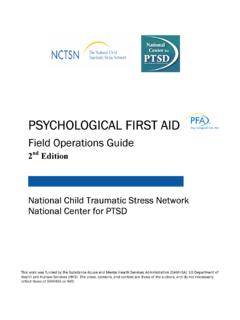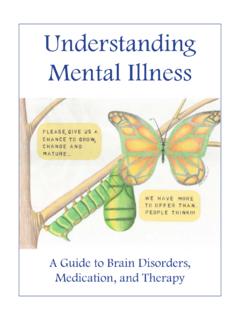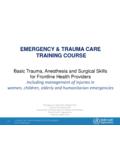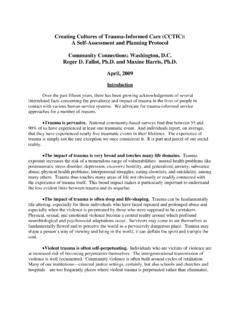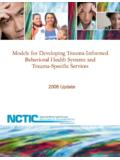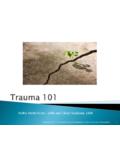Transcription of The Missouri Model: A Developmental Framework …
1 The Missouri Model: A Developmental Framework for trauma - informed The implementation of a trauma - informed approach is an ongoing organizational change process. A trauma - informed approach is not a program model that can be implemented and then simply monitored by a fidelity checklist. Rather, it is a profound paradigm shift in knowledge, perspective, attitudes and skills that continues to deepen and unfold over time. Some leaders in the field are beginning to talk about a continuum of implementation, where organizations move through stages.
2 The continuum begins with becoming trauma aware and moves to trauma sensitive to responsive to being fully trauma informed . Purpose: To ensure that agencies do no harm; to assess the implementation of basic principle of trauma - informed approaches in various organizational settings; to develop a common language and Framework for discussion; and to help increase the effectiveness of services, wherever and whatever they are, by increasing awareness of trauma . Application: To a very wide range of settings, including but not limited to behavioral health services.
3 Use: Not for formal evaluation or certification, but for informational purposes To help anyone who is interested (clients, advocates, other agencies, etc.) determine whether a particular agency or setting is meeting basic criteria for integration of trauma principles To help agencies identify where they are on the continuum and where they want to be. Organizations can choose the appropriate place on the continuum based on their needs and setting. This document was developed by a group of Missouri organizations, MO State trauma Roundtable, that have been active champions in addressing the impact of trauma and working towards becoming trauma informed organizations.
4 They represent a variety of organizations that serve children, youth, families and/or adults in a variety of settings including healthcare, inpatient psychiatric, substance use disorder, and community based mental health services. List of organizations on the Roundtable is found on the last page. Anyone is free to use this document but would appreciate notification of such to The recommended citation when used is Missouri Model: A Developmental Framework for trauma informed , MO Dept. of Mental Health and Partners (2014).
5 trauma Aware Definition Processes Indicators Resources Key Task: Awareness and attitudes trauma aware organizations have become aware of how prevalent trauma is and have begun to consider that it might impact their clientele and staff. Leadership understands that knowledge about trauma could potentially enhance their ability to fulfill their mission and begins to seek out additional information on the prevalence of trauma for the population served. Awareness training is offered (including definitions, causes, prevalence, impact, values and terminology of trauma - informed care.)
6 People are made aware of how and where to find additional information, and are supported in further learning. The organization explores what this new information might mean for them and what next steps may need to be taken. Most staff: 1) know what the term trauma refers to; and 2) are aware that knowledge about the impact of trauma can change the way they see (and interact with) others. The impact of trauma is referenced in informal conversations among staff. Websites: National Child Traumatic Stress Network (NCTSN) National Center on Domestic Violence, trauma and Mental Health ( trauma -aware) Anna National Center for PTSD, Department of Veterans Affairs Resource Center on Violence Towards Women ACE Study Documents: SAMHSA s TIP 57: trauma informed Care in Behavioral Health Services Chapter 2 trauma Awareness.
7 SAMHSA concept paper ( trauma -aware) Anonymous. Dear Doctor. The Permanente Journal, 6(1), Winter 2002 Paul Tough. The Poverty Clinic. The New Yorker, March 21, 2011. Training: DMH training on trauma Awareness trauma Sensitive Definition Processes Indicators Resources Key Task: Knowledge, application, and skill development trauma sensitive organizations have begun to: 1) explore the principles of trauma - informed care (safety, choice, collaboration, trustworthiness, and empowerment) within their environment and daily work; 2) build consensus around the principles; 3) consider the implications of adopting the principles within the organization.
8 And 4) prepare for change. Values of a trauma - informed approach are processed with staff. Through a self-assessment process, the organization identifies existing strengths, resources and barriers to change as well as practices that are consistent or inconsistent with trauma informed care. Leadership prepares the organization for change and leads a process of reflection to determine readiness for change. The organization begins to identify internal trauma champions and finds ways to hire people who reflect in their attitudes and behavior alignment with the trauma informed principles.
9 The organization examines its commitment to consumer involvement and what next steps could be taken. The organization begins to review tools and processes for universal screening of trauma . The organization begins to identify potential resources for trauma specific treatment. The organization values and prioritizes the trauma lens; a shift in perspective happens. trauma is identified in the mission statement or other policy documents. trauma training for all staff is institutionalized, including within new staff orientation.
10 Basic information on trauma is available and visible to both clients and staff, through posters, flyers, handouts, Web sites, etc. Direct care workers begin to seek out opportunities to learn new trauma skills. Management recognizes and responds to compassion fatigue and vicarious trauma in staff. Websites: NCTSN National Center on trauma informed Care (NCTIC) Child trauma Academy International Society for Traumatic Stress Studies Toolkits and Videos: Healing Neen (DVD) Fallot and Harris Organization Self Assessment Tool Risking Connection organizational assessment Institute for Health and Recovery Documents: SAMHSA s TIP 57: trauma informed Care in Behavioral Health Services, 2014.



